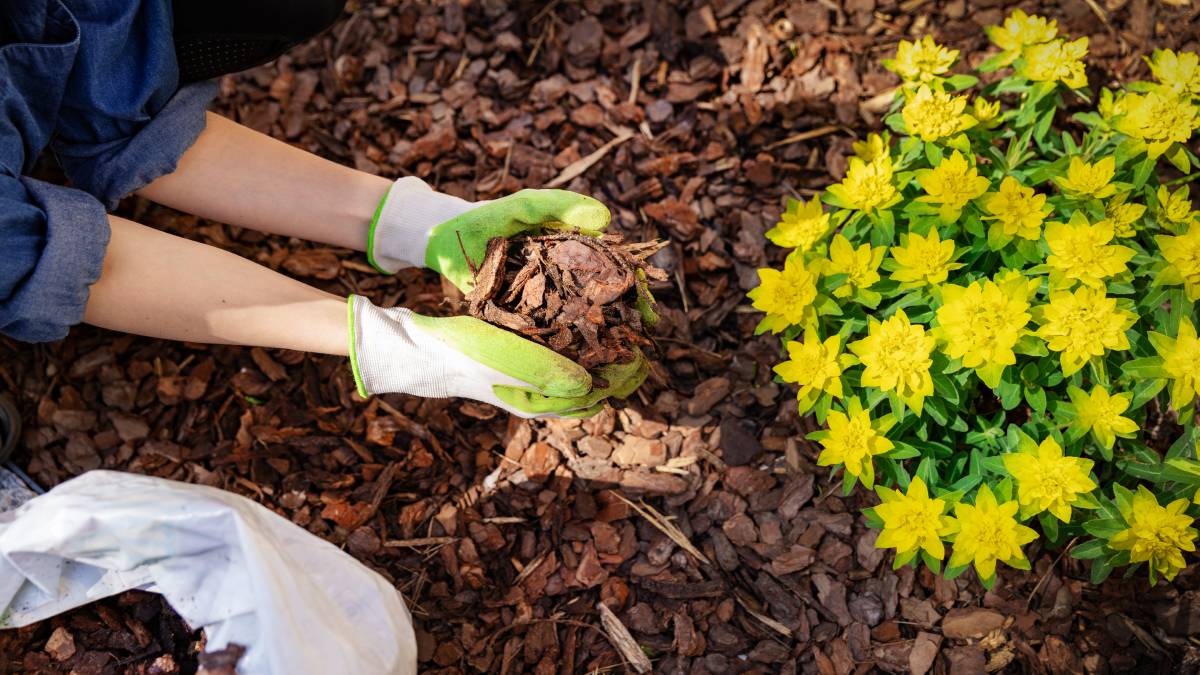What is mulch and why is it so good? What do you need to know to choose the right mulch for your garden?
Roughly, mulch is a generic term for a layer of material spread or laid over the surface of the soil.
That sounds simple, but it can have multiple purposes including suppressing weeds, keeping the soil and plants cool, improving drainage, preventing frost damage, making garden beds and the general landscape more attractive and even creating a micro-climate for helpful bugs. A true over-achiever.
As it serves different purposes, so different mulches may be required.
Light mulches
Straw, pea straw, sugar cane or lucerne mulch are all great for vegie gardens and provide an appealing ‘rustic’ look.
They decompose quickly, improving the soil structure and adding nutrients as they go.
But slugs and snails love them, so avoid spreading them around low-hanging fruit such as strawberries.
However, straw is a great habitat for beneficial insects such as spiders.
And the smaller the plant, the smaller the mulch pieces should be. Try and find chopped straw, or even some form of chaff, or cut it yourself.
Smaller, or baby plants will do much better if they are not in danger of being swamped by mulch.
Straw is also easy to dig back into the soil once the growing season is over, adding to the soil structure for next season’s crops.
Heavier mulches
Bark and tree mulches serve two purposes, they can be beneficial additions to the soil, or a great landscaping tool.
Lighter bark mulches are better on your garden, and heavier bark mulches are suited for pathways or to mark out different areas of your garden.
You can buy them, or next time you prune or cut a tree down, consider hiring a wood chipper and making your own.
Larger hardware stores will even carry a range of colours to match your landscape design.
If you are considering putting them under a children’s play area, make sure the mulch is the correct grade, you don’t want to hurt their delicate feet.
These mulches are not the best idea for landscapes with slants or wet environments. They easily pop up and float away or tumble down slopes.
If you have native plants and trees, it’s also a good idea to consider ‘euky’ mulch. This has been formed from eucalyptus trees and mimics the natural habit your natives would find in the wild.
Grass clippings
You probably want to use everything in the garden, but don’t get carried away with grass clippings.
They can serve a purpose – as great weed suppressants – but often the minuses outweigh the pluses.
Spread them too heavy and they may decompose too rapidly and get slimy, spread them too sparsely and they serve no purpose at all.
They’re best suited to open, unplanted areas or mix them up with a lighter mulch such as pea straw.
If you want to return them to your lawn, it’s recommended drying them out first, and then spreading over in an even layer.
Or you can leave them on the grass as you mow, but maybe every second mow, and only if the grass is relatively short to begin with.
Dumping some in your compost can help bulk out your output, which leads us to …
Compost
Yep, sometimes it’s just as easy as spreading around a bit of compost.
Whether you make your own or bought it from a garden centre or hardware shop, a layer of compost is a simple, easy, highly effective mulch.
You can spread it around, or dig it in a bit, and water it in well.
Once again, garden centres or hardware stores will even have specific composts for things such as natives, roses and garden beds.
And the best time to apply mulch. Well if your soil is really rubbish, probably straight away, but for a mature garden, early to late spring is best. Make it a part of your garden spring ‘cleaning’.
Also read: Gardeners warned after Legionnaires disease leads to death
What tips have you found to help you choose the right mulch for your garden? Why not share them with our members?

